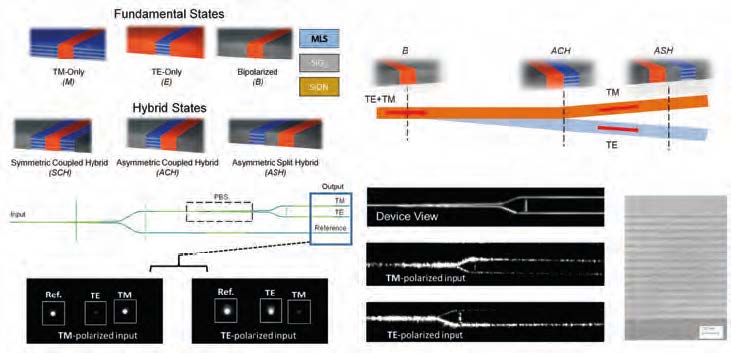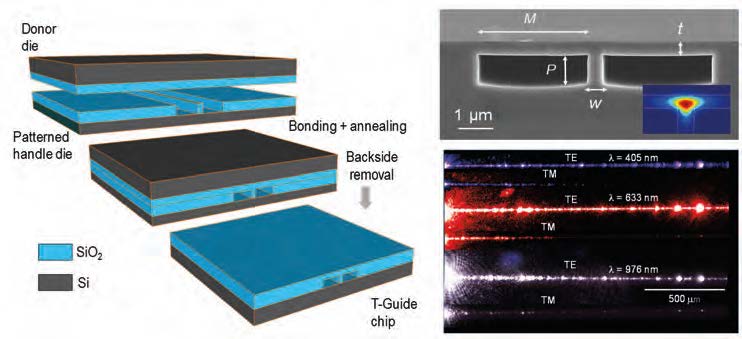Studying the polarization of light has been pursued for over two centuries, since Étienne Malus did the first related observations using a birefringent calcite crystal in 1808. Nowadays, most people have at least heard of “polarized sunglasses” — an 80-year-old invention. Engineering the polarization properties of guided waves in integrated photonic devices, however, has not been as easy. For starters, optical waveguides are, in general, not that sensitive to polarization. In symmetric slab waveguides, for example, the transverseelectric (TE) and transverse-magnetic (TM) modes always coexist and single-polarization behavior is not possible. The single-mode single-polarization (SMSP) property exists in asymmetric slab waveguides, but occurs in a tiny wavelength range very close to the cutoff . The constraints relax a bit more in 2-D waveguides. Especially, TE-only operation with limited bandwidth is possible in shallowly-etched ridge waveguides, but again for wavelengths close to cutoff and at the expense of large lateral mode size and poor confinement.
Another challenge of managing polarization in integrated photonics has been realizing polarization-manipulating components. A good example is polarization beam-splitt ers (PBS), a device not easily achievable in integrated photonics. To date, integrated PBS with optical bandwidths of up to 150 nm have been achieved in the telecommunication band through the use of mode-evolution in complicated silicon photonic tapered directional couplers. However, higher optical bandwidth are challenging due to limits imposed by multimode operation at short wavelengths, and by weaker effective index contrast between polarizations at longer wavelengths.


These challenges were taken up by the now gradated CREOL Ph.D. student, Jeff Chiles, at Prof. Sasan Fathpour’s group. Jeff was working on a novel type of all-silicon (air-clad) anchored membrane waveguide for mid-infrared applications, when he discovered that the T-shaped structures appear to have enormous SMSP bandwidths. Detailed simulations showed 2.75 octaves (1.2 – 8.1 μm wavelength range) bandwidths in the silicon T-Guides. Jeff later experimentally demonstrated a record SMSP window of > 1.27 octaves (405 – 976 nm) in silica T-Guides, limited only by the available measurement equipment. Such ultrabroadband SMSP operation is, in essence, possible because of the high asymmetry of the T-Guides, when compared to conventional channel or ridge waveguide. The SMSP devices may find applications in, e.g, on-chip optical gyroscopes, which can suffer from polarization fluctuation-induced noise.
Later, Fathpour’s team took the idea of highly asymmetric waveguiding structures even further and realized a complete new way of making polarization-sensitive integrated photonics, by a scheme coined topographically anisotropic photonics (TAP). The core idea of TAP mimics the concept of bulk-optics wire-grid polarizers to some degree. Imagine a polarized beam travelling parallel to the interfaces of a multilayer stack of nanometer-scale films of periodic alternating indices. It is expected intuitively that such an engineered anisotropic medium possesses uniaxial birefringence for polarizations parallel or perpendicular to the film interfaces. By embedding regions of such anisotropic films as well as standard regions of isotropic media into different configurations of waveguide core and lateral cladding materials, unique polarization dependent behavior can be achieved over exceptionally broad bandwidths. The relevant fundamental “states” can be TE-only, TM-only or bipolarized. Hybrid states, with symmetric and antisymmetric guiding properties, are also feasible. Polarization-selective devices can be constructed by selecting a series of these states and introducing adiabatic transitions between them. For example, integrated PBSs with an unprecedented bandwidth of 116 THz (0.52 octaves), insertion loss of < 1.2 dB and extinction ratio of > 16 dB are experimentally demonstrated using multilayer stacks of silicon dioxide (SiO2) and silicon nitride (SiN). Other demonstrated devices include TE- and TM-pass polarizers and single-polarization microring resonators.
Jeff Chiles graduated in 2016 and is currently a postdoctoral associate at NIST. Tracy Sjaardema, a second-year CREOL Ph.D. student, has been continuing the TAP work and some of the later results are her courtesy. The work is funded by the NSF CAREER Program.
Author
